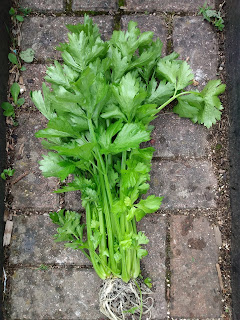Bob Flowerdew is dismissive of garden shredders ("shredders make materials more suited for composting but are dangerous, noisy and irksome to use"); an opinion he has oft repeated on Gardeners' Question Time (GQT) with comments like as "I cannot see the point of them".
As with everything in life, things are more nuanced and a bit more complicated than that. For a start, his garden - at around an acre - is much bigger than most people's so he has plenty of space to (i) allocate to composting, and (ii) provide material for his compost heaps. Those of us with small town gardens are more limited on both counts, especially if we want to devote most of the garden to leisure and/or growing flowers & vegetables. My garden, which is above average for an urban garden, is about 0.05 acre or 1/20th the size of Bob's!
I bought my first shredder in 2012 when I got serious about composting. Due to the lack of garden space and a requirement to compost kitchen waste (including cooked food), I went down the 'hot composting' route buying my first HotBin. In addition to my own garden waste, I was also taking in neighbours' green waste to avoid them making regular trips to the municipal waste depot. Shredding increases composting rates by coarsely chopping garden waste to increase surface area and disrupt plant cell walls to facilitate microbial breakdown of the organic matter. Shredding also reduces the volume of garden waste by about 50% to minimise pre-composting storage requirements. For example, a neighbour recently had their hedge trimmed professionally and I was able to deal with the 2 cubic metres of cuttings with ease by shredding and storing prior to adding to my composters.
There are two types of shredder for small gardens:
Impact Shredders have a rotating cutting blade through which the garden waste is hand-fed. These shredders are the cheaper, lighter but noisier of the two types. The cutting blades cost around £20 and are reversible to double their lifespan before replacement or resharpening. These shredders are suitable for both woody (hard) and green (soft) garden waste and are my preferred choice for preparing garden waste for composting. They also make short work of stale loaves of bread! Whether for wood chipping or chopping green waste, this type of shredder is a good all-round choice.The Bosch AXT 2200 is a typical example.
Roller or Drum Shredders have ridged rollers/drums that draw the garden waste in so are easier (less tiring) to use and best for larger volumes. They are quieter but heavier and more expensive. Maintenance is lower as the cutting/crushing mechanism does not require regular replacement. This type of shredder is great for woody material such as branches but less good for soft green material which can cause the drum/rollers to jam. Buying a machine with a reverse option is a good choice. The Bosch AXT 25 TC Quiet Shredder is a typical example.
In the foreground is my new Bosch AXT Rapid 2200 shredder purchased in November 2020. In the background is the defunct machine it replaced. My first AXT 2200 was bought in 2012 and did sterling work for just over 5 years before the motor burnt out. The second machine (in the background) was bought in 2017 and lasted 35 months before developing an electrical fault with the on/off switch. These Bosch shredders come with a 2-year guarantee so I thought, that's it, I'll have to buy a replacement which I did.
What I hadn't realised was you get an extra warranty year if you register the machine which, fortunately, I had done back in 2017. I got in touch with Bosch UK and they arranged for a courier to pick up the shredder the following day. Less than a week later, I received an e-mail saying they could not fix it and would send a brand new shredder. It arrived a few days later. That is top notch service. Needless to say, I've registered the current machine and the replacement!
Pricewise, the 2012 shredder cost around £150, the 2017 machine about £180 and the 2020 unit about £200.
Is a shredder a worthwhile investment? I process about 15 cubic metres (15,000 L) of garden waste per year to produce approximately 1.5 to 2 cubic metres of finished compost. I would not be able to process these quantities without a shredder.
















